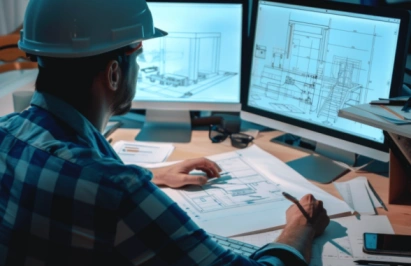In professional settings, precision and compliance with industry standards are non-negotiable. For surveyors and architects, CAD maps are indispensable tools that must be used with care to ensure accuracy and effectiveness in every project. This checklist of best practices will help you make the most of your CAD mapping processes, ensuring that your work meets the highest professional standards.
Professional CAD Maps available here
1. Start with Accurate Data Collection
The foundation of any reliable CAD map is accurate data collection. For surveyors, this means using high-quality instruments like Total Stations, GPS, and laser scanners to capture precise measurements in the field. For architects, this involves gathering detailed site information, including topography, existing structures, and utilities. Ensuring that the data you input into your CAD software is accurate and comprehensive will save time and prevent errors later in the project.
Tip: Regularly calibrate your surveying equipment to maintain accuracy, and always double-check measurements before entering them into your CAD system.
2. Use Layering Effectively
Layering is one of the most powerful features of CAD software, allowing you to organise different elements of your project into manageable sections. Surveyors can use layers to separate topographical data, boundary lines, and utilities, while architects can separate structural elements, plumbing, electrical systems, and more. This organisation not only makes your work easier to navigate but also facilitates collaboration with other professionals who may need to access specific aspects of the project.
Tip: Use clear, consistent naming conventions for your layers to avoid confusion and ensure that anyone accessing the file can easily understand the organisation.
3. Adopt Standardised Templates and Symbols
Consistency is key in professional CAD mapping. Using standardised templates and symbols ensures that your maps are easy to read and interpret, both by your team and by any external parties. This is particularly important when working on large projects or collaborating with multiple stakeholders. By adhering to industry standards, you reduce the risk of misinterpretation and ensure that your maps are universally understood.
Tip: Familiarise yourself with industry-standard symbols and templates, such as those recommended by RICS (Royal Institution of Chartered Surveyors) or the British Standards Institution (BSI).
4. Incorporate BIM for Enhanced Collaboration
Building Information Modelling (BIM) is increasingly becoming a standard practice in architecture and construction. By integrating BIM with your CAD maps, you can create more comprehensive and detailed models that incorporate data from multiple disciplines. This integration allows for better collaboration between architects, engineers, surveyors, and contractors, leading to more efficient project management and reduced errors.
Tip: Ensure that all team members are trained in BIM practices and understand how to integrate their work into a unified model.
Provided by Freepik
5. Regularly Update and Maintain Your CAD Files
Keeping your CAD files up to date is crucial for maintaining accuracy throughout the project lifecycle. Surveyors should update their maps whenever new measurements are taken, while architects should revise their designs to reflect any changes in the project scope. Regular maintenance of your CAD files helps prevent discrepancies and ensures that everyone is working with the most current information.
Tip: Implement a version control system to track changes and maintain a history of revisions, so you can easily revert to previous versions if needed.
6. Ensure Compatibility with Other Software
CAD maps are often just one part of a larger digital ecosystem. Ensuring compatibility with other software, such as GIS, BIM, and project management tools, is essential for seamless integration and data exchange. Surveyors and architects should be mindful of file formats and coordinate systems to ensure that their CAD maps can be easily shared and utilised by other professionals involved in the project.
Tip: Use widely accepted file formats like DWG or DXF, and be aware of any specific requirements from other software systems used in the project.
7. Perform Regular Quality Checks
Quality assurance is a critical step in the CAD mapping process. Regularly review your maps for accuracy, completeness, and compliance with industry standards. This includes checking for errors in measurements, verifying that all elements are correctly layered, and ensuring that the final map meets the project’s specifications. Performing these checks can prevent costly mistakes and ensure that your work maintains a high standard of quality.
Tip: Establish a checklist of quality control steps to follow at each stage of your project, and involve multiple team members in the review process to catch any errors you might miss.
8. Prepare for Future Use and Reusability
Finally, consider the long-term use and reusability of your CAD maps. Organise your files in a way that makes them easy to update and modify for future projects. This includes using clear file naming conventions, keeping your layers organised, and maintaining detailed records of your work. By preparing your maps for future use, you can save time on subsequent projects and ensure that your work remains valuable for years to come.
Tip: Archive completed projects in a secure, accessible format, and include metadata that describes the project scope, location, and key details, so you can quickly reference them in the future.
9. Utilising Automation and Custom Scripts for Enhanced Efficiency
In the evolving field of CAD mapping, surveyors and architects are increasingly turning to automation and custom scripts to handle complex tasks with greater precision and efficiency. These tools are invaluable for managing repetitive processes and ensuring consistency across large-scale projects.
Automation in CAD Mapping: Automation tools within CAD software can significantly reduce the manual workload. Features like macros, batch processing, and automated routines allow you to perform repetitive tasks swiftly and accurately. For example, instead of manually updating attributes across multiple layers or drawings, automation tools can accomplish this in a single operation. This is particularly beneficial when working on projects that require consistent updates across multiple files or when managing extensive datasets.
Surveyors often use automation to generate contour lines or to adjust elevations in response to updated survey data. This ensures that topographic maps are consistent and accurate, reflecting the most current field measurements. For architects, automation can be used to standardise details like door schedules or the placement of fixtures, ensuring uniformity across all project documentation.
Custom Scripts for Specific Tasks: Custom scripts extend the functionality of CAD software, allowing surveyors and architects to tailor their tools to specific project needs. These scripts, often written in programming languages such as Python or LISP (commonly used in AutoCAD), can automate complex or repetitive tasks that go beyond the default capabilities of CAD software.
For instance, a surveyor might create a custom script to automatically convert raw field data into a format that aligns with the project’s coordinate system, ensuring that all measurements are accurate and ready for integration into CAD. Architects might use scripts to generate parametric models, which automatically adjust design elements based on predefined parameters, such as building height or floor area. This capability allows for quick modifications to design concepts without the need for extensive manual adjustments.
Best Practices for Implementing Automation and Scripting:
-
Start with Simple Tasks: Begin by automating basic functions or writing simple scripts to automate common tasks. This approach allows you to build a solid understanding of the process before tackling more complex tasks.
-
Thorough Testing: Before applying any automation or scripts to critical project files, conduct comprehensive testing to ensure they function correctly and do not introduce errors. This is especially important for scripts that handle large datasets or complex geometries.
-
Document Processes: Maintain detailed documentation for any automation tools or scripts you develop. This documentation should include instructions on how to use the tools, as well as notes on any potential issues. Proper documentation ensures that others on your team can understand and utilise these resources effectively.
-
Continuous Learning: Automation and scripting languages evolve over time, offering new features and capabilities. Staying updated with the latest developments allows you to continually refine your processes and take advantage of new efficiencies.
Integration with Other Software: Automation and scripting are most effective when integrated with other tools in your CAD environment. For example, automated processes in CAD can be linked with GIS systems to update geographical data or with BIM software to synchronise model updates. This integration ensures that all aspects of a project remain consistent and up-to-date.
Provided by Freepik
By following these best practices, surveyors and architects can maximise the accuracy, efficiency, and effectiveness of their CAD mapping processes. From accurate data collection to regular quality checks, each step plays a crucial role in ensuring that your work meets professional standards and contributes to the success of your projects. Implement these practices into your daily workflow to enhance your CAD mapping and deliver exceptional results.

